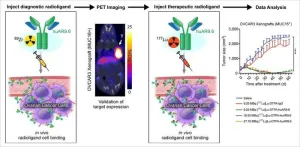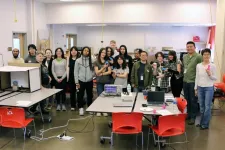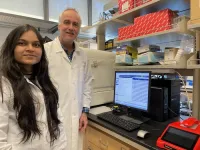(Press-News.org) Reston, VA—A new radiotheranostic system has the ability to detect and treat ovarian cancer noninvasively, according to new research published in the April issue of The Journal of Nuclear Medicine. Combining the highly specific huAR9.6 antibody with PET and therapeutic radionuclides, this theranostic platform may provide more personalized treatment to improve health outcomes for ovarian cancer patients.
Ovarian cancer causes more deaths than any other gynecologic malignancy, with a five-year survival rate below 30 percent for patients diagnosed at advanced stages. The current standard of care for ovarian cancer consists of surgery followed by platinum-based chemotherapy; however, these methods have failed to increase overall survival rates in patients because of tumor recurrence and chemoresistance.
“Current serum-based biomarkers do not sufficiently detect all occurrences of early-stage ovarian cancer,” stated Jason Lewis, PhD, Chief Attending of Radiochemistry and Emily Tow Chair at Memorial Sloan Kettering Cancer (MSK) in New York, New York. “Therefore, there is a critical need for both additional detection methods and new targeted therapies that can improve patient survival.”
Studies have shown that the MUC16 protein is overexpressed in ovarian cancer patients, with elevated levels correlating with disease stage and tumor volume. The antibody huAR9.6 binds to a unique epitope that is influenced by truncated carbohydrate residues on MUC16. Thus, the authors noted, MUC16 could be a potential target for tumor detection via immuno-PET imaging and treatment with radioimmunotherapy.
In the study, the diagnostic radiotracer 89Zr-DFO-huAR9.6 was investigated in vitro and in vivo via binding experiments, immuno-PET imaging, and biodistribution studies on ovarian cancer mouse models. In addition, ovarian xenografts were used to determine the safety and efficacy of the therapeutic radionuclide, 177Lu-CHX-A″-DTPA-huAR9.6.
MUC16 proteins were successfully detected via immuno-PET imaging with 89Zr-DFO-huAR9.6. In vivo studies showed that 89Zr-DFO-huAR9.6 could effectively specify varying levels of MUC16 expression in ovarian cancer mouse models. Radioimmunotherapy studies with 177Lu-CHX-A″-DTPA-huAR9.6 demonstrated improved overall survival and strong antitumor responses in highly MUC16-expressing models. Hematologic toxicity was also determined to be transient in mice treated with 177Lu-CHX-A″-DTPA-huAR9.6.
“Immuno-PET imaging of MUC16 with this radiotheranostic pair may allow for noninvasive diagnosis and treatment monitoring of ovarian cancer lesions in patients,” said Kyeara Mack, PhD, postdoctoral fellow in the Lewis Lab at MSK. “This theranostic platform may be used to stratify and select patients who would benefit from the targeted radioimmunotherapy. In addition, it could also play a significant role in early ovarian cancer detection.”
This study was made available online in March 2024.
The authors of “Interrogating the Theranostic Capacity of a MUC16-Targeted Antibody for Ovarian Cancer” include Kyeara N. Mack, Department of Radiology, Memorial Sloan Kettering Cancer Center, New York, New York, and Department of Pharmacology, Weill Cornell Graduate School of Medical Sciences, Weill Cornell Medicine, New York, New York; Zachary V. Samuels, Lukas M. Carter, Tara D. Viray, and Komal Mandleywala, Department of Radiology, Memorial Sloan Kettering Cancer Center, New York, New York; Cory L. Brooks, Department of Chemistry and Biochemistry, California State University, Fresno, California; Michael A. Hollingsworth and Prakash Radhakrishnan, Eppley Institute for Research in Cancer and Allied Diseases, University of Nebraska Medical Center, Omaha, Nebraska; and Jason S. Lewis, Department of Radiology, Memorial Sloan Kettering Cancer Center, New York, New York, Department of Pharmacology, Weill Cornell Graduate School of Medical Sciences, Weill Cornell Medicine, New York, New York, and Molecular Pharmacology Program, Memorial Sloan Kettering Cancer Center, New York, New York.
Visit the JNM website for the latest research, and follow our new Twitter and Facebook pages @JournalofNucMed or follow us on LinkedIn.
###
Please visit the SNMMI Media Center for more information about molecular imaging and precision imaging. To schedule an interview with the researchers, please contact Rebecca Maxey at (703) 652-6772 or rmaxey@snmmi.org.
About JNM and the Society of Nuclear Medicine and Molecular Imaging
The Journal of Nuclear Medicine (JNM) is the world’s leading nuclear medicine, molecular imaging and theranostics journal, accessed more than 16 million times each year by practitioners around the globe, providing them with the information they need to advance this rapidly expanding field. Current and past issues of The Journal of Nuclear Medicine can be found online at http://jnm.snmjournals.org.
JNM is published by the Society of Nuclear Medicine and Molecular Imaging (SNMMI), an international scientific and medical organization dedicated to advancing nuclear medicine and molecular imaging—precision medicine that allows diagnosis and treatment to be tailored to individual patients in order to achieve the best possible outcomes. For more information, visit www.snmmi.org.
END
Novel theranostic tool allows for noninvasive identification and treatment of ovarian cancer
2024-04-04
ELSE PRESS RELEASES FROM THIS DATE:
An NSF bootcamp for future scientists
2024-04-04
Research today doesn't only occur in a lab; indeed, many university researchers extend their work into the community with the goal of inspiring the next generation of scientists and engineers. And some government agencies, like the National Science Foundation, provide the funding to do so. Most recently, Xiayun Zhao, assistant professor of mechanical engineering & materials science at the University of Pittsburgh, completed such outreach at the Carnegie Science Center (CSC).
Zhao ...
Small protein plays big role in chronic HIV infection
2024-04-04
RIVERSIDE, Calif. -- NeuroHIV refers to the effects of HIV infection on the brain or central nervous system and, to some extent, the spinal cord and peripheral nervous system. A collection of diseases, including neuropathy and dementia, neuroHIV can cause problems with memory and thinking and compromise our ability to live a normal life.
Using a mouse model of neuroHIV, a research team led by biomedical scientists at the University of California, Riverside, studied the effects of interferon-β (IFNβ), a small protein involved in cell signaling and integral to the body’s natural defense mechanism against viral infections. The researchers found that higher or lower than ...
Perinatal women of Mexican descent propose solutions to pandemic-related stressors affecting Latinos
2024-04-04
CHAMPAIGN, Ill. — Public policies blocked many families of Mexican descent living in the U.S. from accessing vital services such as food and mental health care during the COVID-19 pandemic, even though these communities experienced some of the highest infection and mortality rates.
Thirty-eight perinatal women and mothers of young children were interviewed about the challenges they faced during the pandemic and proposed solutions to better meet the needs of their communities during future large-scale crises in a study led by University of Illinois Urbana-Champaign kinesiology and community health ...
Novel biological mechanism discovered that could lead to new treatments for neurological disorders, cancers
2024-04-04
The lab of Yongchao C. Ma, PhD, at Stanley Manne Children’s Research Institute at Ann & Robert H. Lurie Children’s Hospital of Chicago discovered a fundamental biological mechanism that could lead to new treatments for neurological diseases, such as spinal muscular atrophy (SMA) and autism, as well as different cancers. The study was published in the journal Human Molecular Genetics.
Dr. Ma’s team found that chemical modification of RNA (called RNA methylation) regulates mitochondrial ...
Stellar collisions produce strange, zombie-like survivors
2024-04-04
Despite their ancient ages, some stars orbiting the Milky Way’s central supermassive black hole appear deceptively youthful. But unlike humans, who might appear rejuvenated from a fresh round of collagen injections, these stars look young for a much darker reason.
They ate their neighbors.
This is just one of the more peculiar findings from new Northwestern University research. Using a new model, astrophysicists traced the violent journeys of 1,000 simulated stars orbiting our galaxy’s central supermassive black hole, Sagittarius A* (Sgr A*).
So densely packed with stars, the region commonly experiences brutal stellar collisions. ...
Rusty-patched bumblebee’s struggle for survival found in its genes
2024-04-04
A team of researchers has uncovered alarming trends in the first range-wide genetic study of an endangered bee species. The study, led by Colorado State University and published in the Journal of Insect Science, will inform conservation and recovery efforts for the rusty-patched bumblebee – a species that was once common in the United States but has declined from about 90% of its historic range.
The rusty-patched bumblebee was the first bee species to be federally listed as endangered in 2017 through the U.S. Endangered Species Act. Its numbers dropped rapidly starting in the late 1990s, likely due to a combination of pesticides, ...
Research collaboration aims to enhance cereal crop resilience to acidic soils and improve agriculture sustainability
2024-04-04
ST. LOUIS, MO., April 4, 2024 — Acidic soil caused by changing climate patterns threatens agriculture sustainability across the globe. But the problem goes far beyond rising temperatures. One major cause for concern is more acidic soil, a product of increasing rainfall. Acidic soils with low pH are widespread globally and common in tropical and sub-tropical regions, where food security is a serious challenge. Climate change has exacerbated the problem. Acidic soil can result in aluminum toxicity, putting further stress on global agriculture. A new collaborative research team from the US and Brazil received a $2 ...
Introducing New York Valves: The Structural Heart Summit
2024-04-04
NEW YORK – April 4, 2024 – The Cardiovascular Research Foundation® (CRF®) is excited to introduce New York Valves: The Structural Heart Summit, the expanded next iteration of our renowned annual Transcatheter Valve Therapy (TVT®) conference. Taking place June 5-7, 2024, at the Jacob K. Javits Convention Center, North in New York City, the new summit will be a world-class educational experience in the field of structural heart interventions.
“New York Valves 2024 signifies an important milestone for our organization,” said Juan F. Granada, MD, President and Chief Executive Officer of CRF® and New York ...
"Drop industrial agriculture": Major study reports that people and environment both benefit from diversified farming, while bottom lines also thrive
2024-04-04
Mixing livestock and crops, integrating flower strips and trees, water and soil conservation and much more: Massive new global study led by the University of Copenhagen and University of Hohenheim, has examined the effects of diversified agriculture. The conclusion is abundantly clear – positive effects increase with every measure, while negative effects are hard to find.
Laura Vang Rasmussen of the University of Copenhagen can finally wipe the sweat from her brow. For the last four years, she has served as the link between 58 researchers on five continents and as lead author of a major agricultural study which gathered ...
Portable swept-source Raman spectrometer for chemical and biomedical applications
2024-04-04
In 1928, Indian physicist Sir C. V. Raman and his colleague K. S. Krishnan discovered that when light interacts with matter, parts of the scattered light undergo changes in energy due to interaction with molecular vibrations, resulting in what is known as Raman scattering. The discovery laid the foundation for Raman spectroscopy, a technique that takes advantage of these energy changes to create a unique fingerprint of the molecular structure of the material.
Currently, dispersive Raman spectroscopy ...







